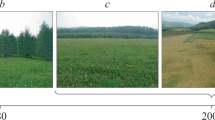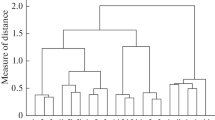Abstract
The current status of the forest fund is discussed. The agroforestry melioration potential of the Western Kazakhstan region is assessed. The modern silviculture stage on the area studied is described. Biodiversity depletion is noted, and possibilities for conservation of the existing natural and artificial protective plantings in the extreme conditions of Western Kazakhstan are assessed. Floodplain forests, chopping sand massifs and estuary-type depressions, and gully and ravine forests are considered as key botanical and landscape territories of the surveyed area. Three key areas, namely, the experimental planting at the Janybek Research Station, aspen on Bolshaya Ichka Mountain, and the Pershinskiy forest are characterized. The necessity of applying new agroforestry land use and practice is justified.

Similar content being viewed by others
REFERENCES
Anuchin, N.P., Lesnaya taksatsiya (Forest Inventory), Moscow: Lesnaya Promyshlennost’, 1982.
Dudorev, M.A., Les i pole (Forest and Field), Saratov: Privolzh. Knizh. Izd., 1984.
Fursaev, A.D. and Khvalina, N.Ya., The nature of vegetation of the Ural River valley from Ural’sk to the Caspian Sea, Uch. Zap. Sarat. Univ., 1946, vol. 16, no. 1, pp. 123–145.
Ivanov, V.V., Groves and forest outliers of the Northern Caspian, Izv. Vses. Geogr. O-va, 1960, vol. 92, no. 2, pp. 136–144.
Kucherov, V.S. and Akhmedenov, K.M., Pershinskii Forest as a soil fertility monitoring object of the steppe zone of the West Kazakhstan region, Pochvoved. Agrokhim., 2011, no. 1, pp. 78–82.
Mamysheva, M.V. and Darbaeva, T.E., Environmental assessment of the state of oak forests of the middle reaches of the Ural River, Vestn. Kazakh. Nats. Univ., Ser. Biol., 2014, no. 1, pp. 85–89.
OST 56-69-83. Ploshchadi probnye lesoustroitel’nye. Metod zakladki (OST 56-69-83. Forest Management Test Areas: Laying Methods), Moscow: Gos. Komitet SSSR po lesnomu khozyaistvu, 1984.
Petrenko, A.Z., Dzhubanov, A.A., Fartushina, M.M., Chernyshev, D.M., and Tubetov, Zh.M., Zelenaya Kniga Zapadno-Kazakhstanskoi oblasti. Kadastr ob"ektov prirodnogo naslediya (Green Book of the West Kazakhstan Region: Inventory of Natural Heritage Objects), Ural’sk: Zapadno.-Kazakh. Gos. Univ., 2001.
Sapanov, M.K., Ekologiya lesnykh nasazhdenii v aridnykh regionakh (Ecology of Forest Plantations in Arid Regions), Tula: Grif i K, 2003.
Sapanov, M.K., Causes for drying English oak cultures on hydromorphic meadow-chestnut soils of the Northern Caspian, Lesovedenie, 2005, no. 5, pp. 10–17.
Sukachev, V.N. and Zonn, S.V., Metodicheskie ukazaniya k izucheniyu tipov lesa (Guidelines for Studying Forest Types), Moscow: Akad. Nauk SSSR, 1961.
Voronkova, E.V., Oak forests growing in gills of the middle reaches of the Ural River basin as the key botanical territories of the West Kazakhstan region, Povolzh. Ekol. Zh., 2012, no. 4, pp. 459–463.
ACKNOWLEDGMENTS
Research work was supported by the Ministry of Education and Science of the Republic of Kazakhstan, project no. 4037/GF4 “Study of Arid Ecosystems in the Conditions of Climate Change and Anthropogenic Influence for Adaptation of Land Use Methods.”
Author information
Authors and Affiliations
Corresponding author
Additional information
Translated by S. Kuzmin
Rights and permissions
About this article
Cite this article
Akhmedenov, K.M. Analysis of the Afforestation Status in the Arid Conditions of Western Kazakhstan. Biol Bull Russ Acad Sci 45, 1153–1158 (2018). https://doi.org/10.1134/S1062359018100023
Received:
Published:
Issue Date:
DOI: https://doi.org/10.1134/S1062359018100023




